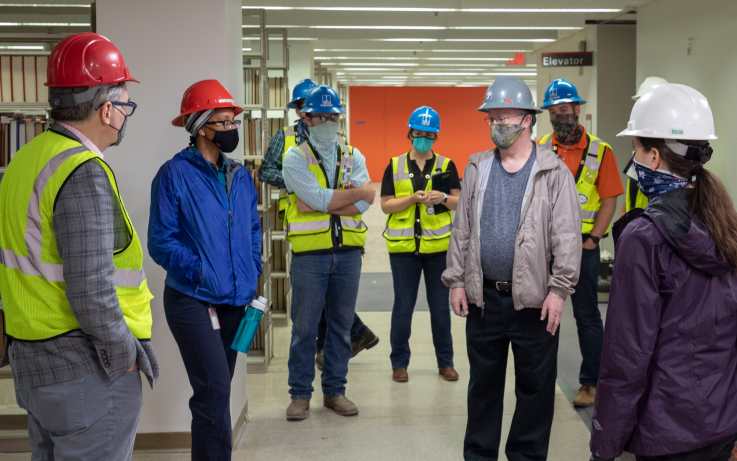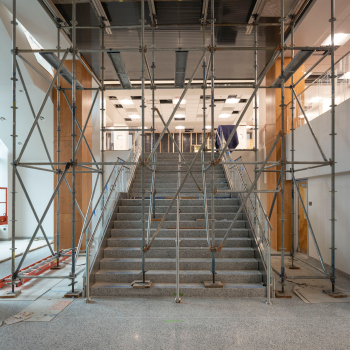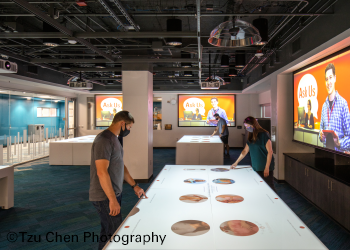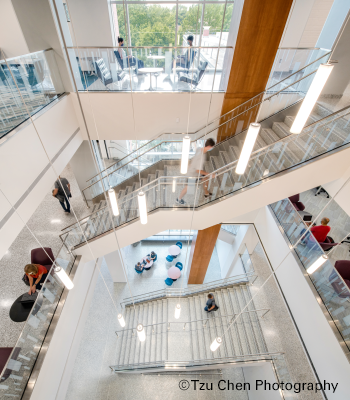
The unique partnership behind the Hill Library renovation

Although the fall semester has been full of challenges, students and faculty have offered a universal expression of excitement about the newly renovated Hill Library. New spaces like the Academic Success Center, Data Experience Lab, and Innovation Studio are impressive. The long windows looking out onto campus are providing great views. The bright, open staircase inside the Brickyard entrance is a jaw-dropper. Oohs and aahs have been audible even through people’s masks.
If you want to ooh and aah at something else, consider planning, managing, and executing a major renovation of one of the university’s busiest buildings without closing it or compromising its operations, and bringing the project in on time despite the unprecedented challenges of the coronavirus pandemic. This accomplishment is thanks to a unique partnership between the Libraries, the university’s Capital Project Management (CPM) group, the Office of the University Architect (OUA), construction contractors at Holder Construction, and designers at Lord Aeck Sargent (LAS).

The key team members in the partnership include Patrick Deaton, Associate Director of Learning Spaces and Capital Management at the Libraries; Danelle Gambrell, Construction Project Manager at CPM; Chris Johnson, Facility Planner in the OUA; Shaun Haycock, Jordan Moran, and Daniel Snyder at Holder Construction; and architects Kelly Yates and Neil King, and interior designer Janene Winstead, at LAS.
Additionally, in order to plan and prepare for the renovation, dozens of Libraries staff were involved in several teams focused on specific areas of the project. Deaton lauds the work of prep teams that moved collections and removed furniture from the second and third floors, as well as those who planned the technologies, staffing, and service models for each new space. “Without this critical, behind-the-scenes work, a new space will not fulfill its potential, no matter how thoughtfully designed and furnished,” Deaton says.
While staff was moving nearly one million books to Hill’s upper floors, the design phase of the renovation was underway. Deaton and Johnson worked with Yates and her team as well as campus partners to determine what the new library spaces would be and how they would look and fit together, finishing the design in January 2019. Gambrell oversaw the bidding process that spring, and construction began in May of last year.
Then, Holder’s on-site team moved in for a tricky demolition phase over the quieter summer months, which transitioned into construction as the 2019-2020 school year began. Gambrell managed the construction phase, overseeing the budget and schedule, handling requests for changes, and coordinating with other university departments to address unexpected issues as they arose. Holder completed construction this July, in time for the start of the fall semester in August.
As the point person at the Libraries guiding the Hill renovation from conception to launch, Deaton takes pride in the close coordination of so many partners. “During the design phase, it was a pleasure to work with the Building Committee, the Office of the University Architect, and the staff at the Division of Academic and Student Affairs (DASA) and the Office of Undergraduate Research (OUR) on the location and design of their new spaces,” he says. “Everyone on the design and construction teams seemed to appreciate the importance of this project to the university and to our students, and put their best efforts into making the project successful.”
“I've been extremely impressed with the focus and commitment of campus leadership,” Johnson echoes, admiring the teamwork of so many campus and private partners. “Early on, we certainly faced challenges bringing multiple groups together. However, we emerged with a unified vision and, looking back, I take pride in what we've been able to accomplish as a team.”

Deaton acknowledges the many challenges that the Hill renovation faced—from the coordination of so many partners, to unanticipated design or demolition issues, to the closure of campus and implementation of high-stakes safety measures this spring. “As with any renovation project, unexpected issues arose during construction that had to be addressed. Danelle Gambrell did an excellent job managing these issues within the project’s set schedule and budget.”
Her deft management aside, Gambrell also admires the project’s tight teamwork—particularly between the designers and the contractors. “This is Holder's first project on the NC State campus, and they have done an exemplary job with such a challenging project,” she says. “Renovating an existing building comes with a lot of surprises behind walls and inside slabs, and they stepped up to the plate to handle all of them. And LAS has done a great job at turning NC State's vision for the library into reality with their design.”
As project manager for the LAS design team, Yates was pleasantly surprised by the university’s commitment to that vision. “We are typically provided contact with only a few key players from the project owner’s organization,” she says. “For this project at the Hill Library, we had access to a breadth of contributors from the NC State community.”
“I have been impressed by the continued level of commitment by each of these contributors,” Yates continues, “both to their own goals and to the collaborative process we went through to ensure that all the project needs were met. Through continued communication with this expanded team I felt greatly connected to the impact that this project will have on the NC State community.”
Even with a clearly articulated vision, the design process wasn’t easy. Many programmatic and functional requirements had to be met for DASA, OUR, and the Libraries, all in a way that would allow for future reconfiguration. These requirements meant that the building’s power, data, lighting, audiovisual, HVAC, and plumbing infrastructures needed substantial updates, and the user experience had to be considered from both practical and aesthetic standpoints.
“We wanted the design of the new spaces to be informed by some of the lessons learned at the Hunt Library, but we did not want to try to duplicate those spaces,” Deaton says. “The Hill Library has its own personality. Parts of it are mid-century modern, other parts are more traditional, and—probably because it has been expanded and renovated so many times—it can feel slightly quirky. We didn’t want to lose that, because we think our students appreciate having a variety of spaces.”

To Yates’s mind, the light-filled stairs unify all those quirks beautifully. “The new connecting stair is one of the main design features of this project, and it is located across the seam between the 1970s building and the 1990s addition,” she says. “We needed to develop a design that would conceal the structural challenges and provide a consistent, stunning visual appearance that ties the whole project together.”
Johnson sees the stairs as the biggest design challenge—and a big opportunity, too. “Cutting a vertical section through the building and connecting four floors not only offered the opportunity to experience the building in a new way, it also created a condition which required additional smoke and fire mitigation strategies,” he says. “In the event of a fire emergency, concealed horizontal and vertical fire shutters subdivide the space, reducing the threat of the emergency. The stair also serves as a new wayfinding tool, leading visitors to the Academic Success Center and the technology exploration spaces above.”
“Designing for flexibility is actually incredibly challenging,” Yates adds. “It is difficult for one space to be everything to everyone. The team worked hard to carefully define the intended—and possible future—use cases for each space in the project and we tailored the design to these needs.”
Once the design phase was completed and Holder Construction was selected as the contractor, things started happening inside the library. Students will remember, last year, the first time they walked through the Hill Library’s Hillsborough Street entrance once the Brickyard entrance was closed. Soon thereafter, a wall appeared across from the Ask Us desk to block off the construction area. Through a window left in the wall, curious students could get a peek at the ongoing work around the old main stairwell.
“The project had a small footprint but was complicated in nature,” Moran recalls. “Between the various audiovisual studios and the monumental staircase, the project had much complexity included in a relatively small package.”
Since construction was beginning literally hours after the spring 2019 semester ended in order to try to complete as much of the disruptive work during the summer as possible, Holder started at a sprint. Still—even before the pandemic changed everything—safety was priority one.
“During the construction phase, the primary concern was the safety of everyone in the building and the Brickyard—students, faculty, staff, and the construction workers,” Deaton says. “Another major concern is minimizing disruptions to everyone who is using the building. This involves things like fire alarms, electrical shutdowns, construction noise, and even odors from construction materials.”
Deaton and Libraries staff were thorough with wayfinding signage about which areas of the building were closed and which services had been relocated. Because some construction was happening in the stacks, Deaton worked with Holder to keep those materials protected and secure. An acoustic consultant was brought in to advise on the design of an enclosure around the new mechanical rooms on the fourth floor that are adjacent to study areas. No one wants to hear an air conditioner roar while they’re cramming for exams.
“Hoisting those three large air handler units into the building stands out in my mind,” Moran recalls. “It took critical coordination with the trade contractors and vital NC State staff to achieve this critical path milestone. We were able to mobilize a crane and hoist 20 segments of three different AHUs in two days’ time without delays.”
Some days onsite were about overcoming such challenges. But there were inspiring days too.
“The day Holder started cutting out the concrete slab on the second floor for the now open atrium was a great day,” Gambrell remembers. “It was then you could see LAS's design of the open atrium become a reality. All the light flooding into the new space was a welcomed change.”
No matter how thorough its design or diligent its construction team is, every renovation project encounters unanticipated problems. But no one involved in the Hill Library project could have imagined a global pandemic interrupting campus operations as abruptly as the coronavirus did in March of this year. However, with construction in full swing, the Holder team gathered with Deaton and Gambrell to make adjustments on the fly. The well-coordinated project hardly missed a beat.
“When the pandemic began to disrupt campus operations in mid-March, I think many people assumed that the construction project would slow down or stop completely,” Deaton says. “Thanks to the team at Holder Construction, the project stayed on schedule with only minimal delivery delays of some construction materials. This is a testament to the Holder team’s careful planning and scheduling throughout the project.”
“No matter what, project safety is always our number one concern,” Gambrell adds. “Therefore making sure our NC State employees and designers and construction partners were safe was our first priority. Holder was extremely responsive in updating their project policies and procedures to follow the CDC recommendations to maintain safety on the project site, taking temperatures onsite, managing social distancing, wearing face coverings onsite, and taking additional cleaning measures.”
Asked what he is most proud of about Holder’s role in the Hill renovation, Moran says it’s that the project was completed on time despite the pandemic and critical changes to its scope and design. But then again, it’s hard for him not to talk about the stairs. Symbolic of both the openness and access that librarians are devoted to providing, and the successful partnership of campus and private partners, the new stairwell leaves a lasting impression on everyone.
“Physically speaking, I am most proud of the monumental staircase with its complicated scope of steel, glass, terrazzo, fire shutters, lighting, a curtain wall system, and HVAC,” Moran says. “It was very complicated and the end result turned out beautifully.”
“Anyone who used the Brickyard entrance at the Hill Library before the renovation is likely to be shocked by the scale and appearance of the new four-story stairwell,” Deaton says. “More importantly, they will be able to see into many of the renovated areas as they ascend via the stairs or elevator. I am proud of the variety of new spaces we created such as the Innovation Studio, Data Experience Lab, and the Visualization Studio, and the new services and technologies that will be located within them. From hundreds of new power outlets to a variety of furniture types, we tried to think of everything that the students and faculty might need.”
“I am an NC State alumnus (Construction Engineering & Management, ‘09) and therefore am very familiar with the Hill Library from my time as a student spending many days and nights there studying,” Gambrell says. “Seeing Hill transition from what it was to now include the grand staircase, open atrium, additional studying spaces, new learning and collaborative spaces, along with the new location for the undergraduate tutorial center is incredible. I am excited for the future students who will use this new space.”
Yates, and the team at LAS, are also proud of being a part of a project with such a big positive impact on the student experience at NC State. “As designers, we strive to improve experiences and communities,” she says. “By embracing student services and providing highly visible access to everything the Libraries has to offer, NC State continues to push the boundaries of community engagement.”
Johnson echoes this pride in making the Hill Library even more of a community space: “The project has always been about much more than the construction of a physical space and I believe it will continue to find and refine itself well after opening day, once the students bring it to life.”